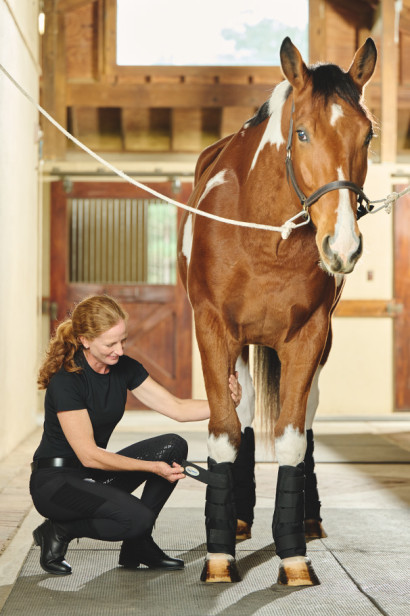Equine Therapy Success Stories: Real People, Actual Psychological Transformations
Wiki Article
Reviewing the Effectiveness of Laser Therapy in Horse Treatment for Injury Recovery
The assessment of laser treatment's performance in equine injury rehab pivots on several aspects, including healing time, pain mitigation, and cells regeneration. Vets often observe premium end results with laser treatment compared to traditional techniques, placing it as an important aspect in equine care.Comprehending Laser Therapy
Laser treatment has actually come to be a crucial device in veterinary medicine, specifically in the therapy of equine problems. Known for its non-invasive nature and efficacy, laser treatment entails the application of details wavelengths of light to boost cells fixing and reduce inflammation. This restorative method is increasingly favored for its capacity to accelerate the healing procedure in steeds struggling with a selection of bone and joint injuries and persistent problems.The primary mechanism behind laser treatment is its capability to improve mobile functions. Furthermore, laser therapy advertises vasodilation, enhancing blood flow and oxygen shipment to damaged tissues, thus speeding up recovery.
In equine medication, laser treatment is especially valuable for conditions such as tendonitis, osteoarthritis, and injury recovery. The method is admired for its pain-relieving residential or commercial properties, permitting horses to restore movement and function extra swiftly. Vets likewise appreciate its very little negative effects contrasted to various other treatment modalities, making it a dependable and safe choice for equine care.

How Laser Therapy Functions

Upon absorption, these photons set off a collection of biochemical changes, enhancing mitochondrial function and causing enhanced adenosine triphosphate (ATP) manufacturing. This increase in ATP speeds up cellular metabolic process, promoting cells repair work and regrowth. Furthermore, laser therapy modulates inflammatory feedbacks by impacting cytokine levels and minimizing oxidative stress, therefore relieving pain and swelling.
Another considerable aspect of laser therapy is its function in enhancing microcirculation. The treatment advertises vasodilation, enhancing blood flow and oxygen delivery to damaged tissues (Equine Therapy). This assists in the elimination of cellular particles and sustains the spreading of fibroblasts and collagen synthesis, crucial for wound recovery
Scientific Evidence
The effectiveness of laser treatment in equine treatment has actually been confirmed with various medical research studies, showcasing its healing potential across a variety of problems. A research study carried out by Turner et al. (2012) showed that equines treated with low-level laser therapy (LLLT) for tendon injuries showed accelerated recovery contrasted to those receiving traditional therapies.Similarly, research by Johnson and coworkers (2015) concentrated on equine muscle injuries, disclosing that laser therapy substantially accelerated muscular tissue fiber regrowth and decreased muscular tissue rigidity. Professional analyses have revealed that laser treatment can ease persistent problems such as osteo arthritis.
Vet Insights

Vets additionally appreciate the flexibility of laser treatment. She aims out that laser therapy can be tailored to the particular needs of each horse, guaranteeing optimum results.
hop over to here Furthermore, veterinarians value the capacity to integrate laser treatment with other therapy techniques. This multimodal approach can improve overall therapy efficiency, offering a comprehensive option for equine rehab. Such recommendations from experienced professionals emphasize the growing acceptance and application of laser therapy a fantastic read in equine medicine.
Practical Factors To Consider
A crucial facet of applying laser treatment in equine treatment involves recognizing the functional considerations that ensure its effectiveness and security. It is vital to select the ideal laser device, as different kinds vary in wavelength, power, and infiltration deepness. Vets have to be skilled in these parameters to customize therapy protocols effectively per injury typeIn addition, the regularity and duration of laser therapy sessions need mindful planning to optimize restorative advantages while reducing any kind of possible unfavorable impacts. Constant surveillance of the steed's feedback to treatment can lead required changes in the therapy program. Developing a safe and regulated environment during treatments is visit additionally important to avoid accidental direct exposure to laser emissions, which can hurt both the equine and the trainer.
Training and qualification of workers administering laser treatment are paramount to make sure appropriate technique and to copyright security requirements. In addition, preserving exact documents of each session, including laser settings and observed results, is important for assessing the general efficiency of the therapy and for making data-driven choices.
Verdict
Laser therapy has actually emerged as an effective modality in equine injury recovery, using considerable benefits in healing time, discomfort relief, and tissue recovery. For ideal outcomes, constant tracking and personalized therapy procedures remain important in leveraging the complete capacity of laser treatment in equine treatment.Report this wiki page